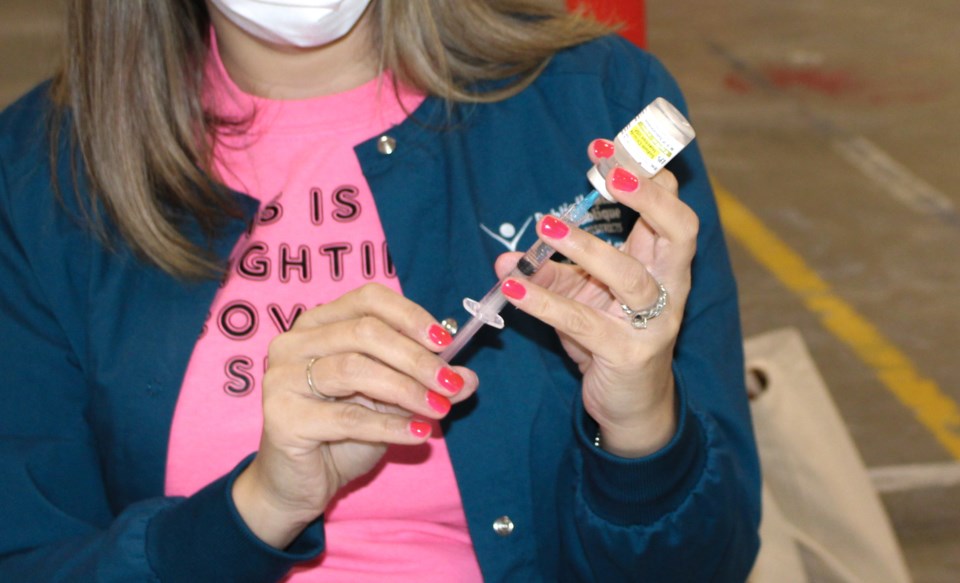Vaccine doses have been wasted in Sudbury. It is now being reported on the daily COVID-19 summary posted by Public Health Sudbury and Districts (PHSD) that a small number of vaccine doses have been "wasted" in the process of delivering tens of thousands of vaccine doses to area residents.
Before getting worried about doses being lost, consider that the health unit is also “recovering” hundreds of new doses, almost ten times the number of doses lost.
For several months now, PHSD had been reporting statistics on the vaccine rollout campaign in the Sudbury district, day by day showing the gradual increase in the number of vaccines being administered as vaccination events were being held.
Then less than a week ago, PHSD added a new category to the summary — Number of wasted doses.
The most recent summary, published at 4 p.m. on May 19, revealed that 118 doses of vaccine were lost.
Percentage wise, this accounts for roughly one tenth of one per cent of the 105,000 vaccine shots — first and second doses — administered in the entire Sudbury public health jurisdiction.
Things like this are not supposed to happen, but when a process is being repeated tens of thousands of times, over and over and over again, mistakes occur, PHSD told Sudbury.com today.
"Locally, some of the reasons for vaccine wastage have included: particulate found in vial, syringe came apart during dilution, difficulty pulling last dose from vial, dropped syringe, preparation error, and clients that were not available for immunizing," said an email response from PHSD.
PHSD said all those who do the actual immunizations work hard to ensure there is minimal wastage.
"This includes ensuring the preparation of vaccine is done correctly and having a contingency plan in place for each clinic if there are remaining doses at the end of the clinic," said the email, which added that public health has also created a daily standby list.
"Public Health Sudbury and Districts along with public health units and vaccination clinics have been issued a directive from the Government of Ontario to implement processes to fill last-minute cancellations and end-of-day remaining doses with people who are eligible to receive the vaccine.
“This process has ensured vaccine wastage is kept to an absolute minimum. As well, Public Health is now offering a COVID-19 vaccination standby list to help administer any remaining doses at the end of each clinic day," said the email.
More doses than advertised
It is not reported in the PHSD daily summary, but just as important in the big picture is the fact that many vials of vaccine actually contain more of the product that expected.
PHSD explained that "extra doses" are often found in the vaccine vials, despite the printed factsheet — or monograph — indicating how much product is inside the tiny glass bottle.
The idea of vials containing additional vaccine was discovered back in December of last year by health care professionals in the United States who learned that after extracting the expected five doses from each vial of Pfizer BioNTech, in many cases there was enough vaccine for a sixth dose.
At first, there was reluctance to take a sixth dose but after studying the issue — and also because vaccine supplies were short — the decision was made that it was okay to use the extra vaccine.
PHSD said this has resulted in a noticeable increase in vaccine doses recovered by local health care workers.
" I can confirm that as of Monday, May 17, we have recovered 1,106 additional doses from vials in excess of their dosage monograph," said PHSD spokesperson Chris Pollesel.
The email response from PHSD outlined how the extra doses are recovered.
"Our reported doses are based on the product monograph and not the actual yield per vial. An additional dose per vial is often obtainable. For example, the product monograph for Pfizer is six and Moderna is 10," said the email from PHSD.
"With the number of doses per vial for Pfizer being six, we almost always get six doses. So for Pfizer, we report based on six doses per vial and anything less would be considered a dose wasted. For Moderna, the number of doses per vial is 10 doses (as per the product monograph). However, the majority of the time we get 11 doses out of a Moderna vial. So we report Moderna doses based on 10 doses and when we are unable to extract an 11th dose, that 11th dose is not considered wasted," said PHSD.
An April 15 newsletter from the World Health Organization (WHO) addressed the idea of why the extra doses are being found so often.
"Filling extra vaccine in a vial is a common practice in vaccine production and is called ‘overfill’. Manufacturers include extra vaccine to aid health workers in delivering the intended number of
accurate doses. Overfill accounts for vial-retained volume (the vaccine left in a vial that cannot be withdrawn), vaccine retained in the dead space of the syringe and needle, and losses of vaccine during the adjustment of the dose if ejected in the air," said the newsletter.
"Volume of vaccine in a vial that is in excess of volume claimed on a vaccine vial label is allowable. Regulators provide guidance to the manufacturers on this. Overfill for a 10-dose vial can be from about 16% to 24% (or 0.58 to 0.62mL fill-volume for a 0.5mL dose). This is why it is possible to withdraw 11 or 12 doses of 0.5 mL from a 10-dose vial when a low dead space syringe is used," the newsletter continued.
Len Gillis is a Local Journalism Initiative reporter at Sudbury.com. He covers health care in Northern Ontario.
